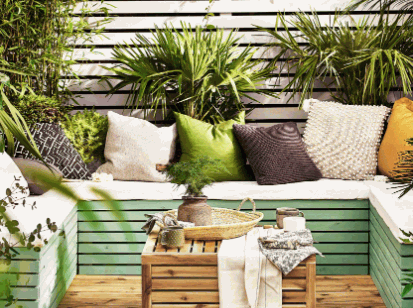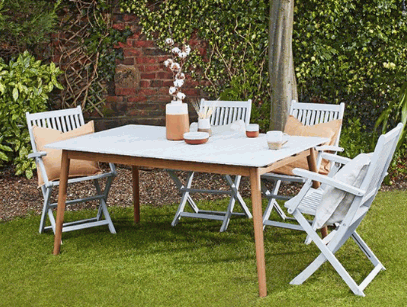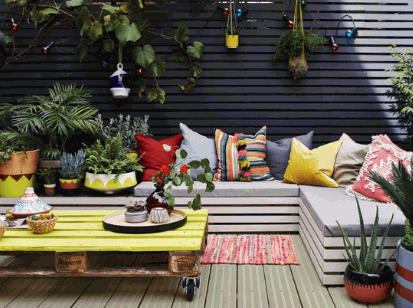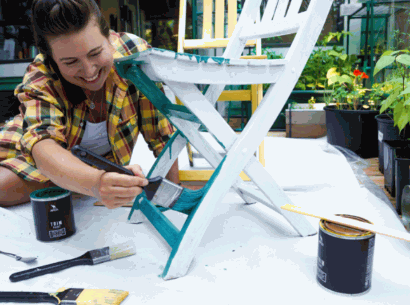- Get a special coating for outdoor furniture to keep it looking good.
- Pick the right paint for the material.
- Clean and prepare surfaces before applying.
- Thin coats and enough drying time are important.
- Following the manufacturer’s instructions helps you get the best result.
Pro Tip: Read and follow safety precautions!

What Is Fence Paint?
Fence paint is a special kind of paint, designed for fences. It helps protect the fence from nature’s elements and makes it look better. It also extends the fence’s life. Resins and pigments make it extra durable and long-lasting.
Fence paint can be used on garden furniture, too. It’s perfect for outdoor surfaces exposed to tough weather. Apply it to garden furniture and you get protection from moisture and sunlight; plus, a new look.
Fence paint comes in a wide range of colors. You can pick a classic white, or a bold, vibrant shade. Some have added features like UV protection and anti-fungal properties. This helps the furniture last longer.

Can Fence Paint Be Used On Garden Furniture?
Fence paint can indeed be used on garden furniture, providing an effective solution for protecting and rejuvenating these pieces. The versatile nature of fence paint allows it to adhere to different surfaces, including wood, metal, and plastic, making it suitable for application on various types of garden furniture.
By using fence paint on garden furniture, you can enhance its durability and longevity. The protective coating created by fence paint helps shield the furniture from harsh weather conditions, such as rain, sun exposure, and temperature fluctuations. Additionally, fence paint offers an attractive aesthetic, allowing you to refresh the appearance of your garden furniture and complement your outdoor space.
It is important to select the appropriate type of fence paint for your garden furniture. Consider factors such as the material of the furniture and the desired finish. For wooden furniture, opt for a paint specifically designed for exterior use and one that is moisture-resistant. For metal or plastic furniture, choose a paint that is suitable for these surfaces.
Pro Tip: Before applying fence paint on your garden furniture, ensure that the surfaces are clean and free from any debris or previous coatings. This will ensure proper adhesion and a smooth, professional-looking finish.
Turn your dull garden furniture into the life of the party with fence paint – because who needs a retirement plan when you can have a rainbow-colored rocking chair?

Benefits Of Using Fence Paint On Garden Furniture
Using fence paint on garden furniture brings lots of advantages! It:
- Boosts the appearance of furniture
- Offers a shield against weather damage
- Barricades against rot and decay
- Adds a splash of color and style to outdoor space
Plus, it provides the liberty to coordinate your furniture with your outdoor decor. There’s a range of colors and finishes to choose from, so you can get creative. Applying fence paint is normally straightforward – ideal for DIY-ers or those searching for a swift update.
For optimal results, prepping the surface is essential. This requires cleaning the furniture and sanding any rough patches. A suitable primer before you start painting will also help with adhesion and durability. To keep your painted garden furniture looking perfect, a bit of maintenance like cleaning and reapplying a protective coat every few years will do the trick.
Factors To Consider Before Using Fence Paint On Garden Furniture
Take into account several factors when considering fence paint for your garden furniture, such as:
- The type of wood
- Weather-resistance
- Color and style
- Drying time
- Longevity
Prep the surface before applying the paint. Use either a brush or a spray applicator. Consider thin coats rather than one thick coat. Additionally, a clear sealant or varnish can give extra protection. Darker colors may fade faster due to sun exposure. Lastly, inspect and maintain regularly to address any signs of damage. Following these steps will help ensure a beautiful, long-lasting finish!
Uncover more: Which Fence Paint Is Sprayable
Step-By-Step Guide On Using Fence Paint On Garden Furniture
Fence paint can indeed be used on garden furniture, providing a durable and visually appealing finish. Here is a step-by-step guide on how to use fence paint on your garden furniture:
- Preparation: Start by preparing the surface of your garden furniture. Clean and remove any existing paint or finish using sandpaper or a wire brush. Ensure that the surface is smooth and free from dust and debris.
- Priming: Apply a suitable primer to the furniture surface. This will help the paint adhere better and ensure a longer-lasting finish. Follow the manufacturer’s instructions for the specific primer you are using.
- Painting: Use a high-quality fence paint that is suitable for outdoor use. Apply the paint evenly using a brush, roller, or sprayer. Make sure to coat all surfaces, including any hard-to-reach areas. Apply multiple thin coats rather than one thick coat for better coverage and durability.
- Drying: Allow the first coat of paint to dry completely before applying additional coats. Follow the manufacturer’s instructions for the recommended drying time. Ensure that the furniture is placed in a well-ventilated area during the drying process.
- Finishing touches: Once the final coat is dry, inspect the furniture for any imperfections or areas that may require touch-ups. Use a fine-grit sandpaper to smooth out any rough areas or drips. Apply additional coats if necessary.
- Maintenance: To ensure the longevity of the painted garden furniture, regular maintenance is essential. Clean the furniture periodically using a mild soap and water solution and a soft cloth. Avoid using abrasive materials or harsh chemicals that may damage the paint.
It’s important to note that different types of garden furniture may require specific paints and finishes. Therefore, refer to the manufacturer’s guidelines or consult a professional if you are unsure about the right type of paint to use.
Lastly, always exercise caution when working with paint and ensure proper ventilation. Wear protective clothing and follow safety guidelines to minimize any risks.
Get ready to strip down your furniture, and by that I mean removing its existing paint, not yourself… unless that’s how you like to prepare for DIY projects.
Preparing The Furniture Surface
To spruce up furniture, take these steps:
- Scrape or sand off any paint or varnish.
- Clean it with a mild detergent and water to remove dirt and grime.
- Rinse it with clean water and let it dry.
- Fill any cracks or imperfections with wood putty.
- Sand the entire surface for a smooth texture.
- Wipe it with a tack cloth to remove any dust.
- Do wear gloves when using chemicals or sanding.
- Refer to the manufacturer’s instructions for the best results.
- A study by Home & Garden mag found prepping the surface before applying paint can extend the finish’s life.
Choosing The Right Type Of Fence Paint
When selecting fence paint, there are many factors to consider. For instance, the color should complement outdoor space or match existing garden furniture. Additionally, there are various types available, such as oil-based, water-based, and acrylic-based. Each offers unique advantages. The finish should reflect personal preference, such as glossy, satin, or matte. Durability is another key factor, as the paint should protect against weather, UV rays, and potential insect/fungi damage. Consider what application method is best: brush, roller, or sprayer. Research different brands and their customer reviews to ensure quality and longevity.
Before applying any fence paint, make sure to prepare the surface properly. Clean furniture and repair damages for best results. Also, read and follow manufacturer guidelines. Furthermore, according to Better Homes & Gardens magazine expert advice, oil-based paint offers better protection against moisture and increased durability compared to water-based options.
Applying The Fence Paint On Garden Furniture
For flawless fence paint on garden furniture, you need to be precise and professional. Here’s a step-by-step guide:
- Prep: Start with cleaning furniture with soap and water. Sand away any rough areas.
- Choose paint: Get high-quality, UV, moisture, and mold-resistant fence paint.
- Prime: Use a primer for adhesion and durability. It’ll stop any stains or discoloration.
- Apply Thin coats with a brush or roller. Cover all surfaces evenly. Let each coat dry before the next one.
- Coverage: Depending on the finish, you may need multiple coats. Let the last coat dry before using.
- Finishing touches: Allow the paint to dry. Complement colors with existing décor and vegetation. Add clear varnish/sealant for extra protection. Check regularly for signs of wear/damage. Store during inclement weather.
By following these steps and suggestions, you can efficiently paint garden furniture and enjoy its beauty and durability for years!

Caring For The Painted Garden Furniture
Caring for painted garden furniture? Follow these 5 steps!
- Clean it with mild detergent and water. Repair any wear or damage.
- Apply a protective finish.
- Store it properly.
- Regular inspections.
Clean to remove dirt and dust. Gently scrub with a soft sponge or brush. Rinse with clean water. Touch up scratches or chips with matching paint or wood stain marker.
Apply a protective finish designed for outdoor use. Follow the manufacturer’s instructions.
Store indoors or cover securely with waterproof covers during harsh winters or non-use.
Inspect periodically for signs of damage or discoloration. Address any issues promptly.
Proper care and maintenance are essential. Cleaning removes dirt particles which act as abrasives.
Repairing prevents moisture penetration. Applying a protective finish adds defense against UV rays, moisture, and mold.
Storage or covering ensures paint is sheltered from harsh weather conditions. Regular inspections allow you to address any issues early on.
Follow these steps for a beautiful outdoor space that lasts!
Conclusion
We’ve explored whether fence paint works on garden furniture. The answer is yes, but with things to consider. We looked at materials, preparation, colors, and finishes. But there’s still more to mention.
Weather conditions can have an effect on how long the paint lasts. If it’s too hot or cold, it can crack or peel. So, use a product that’s suitable for outdoors in your climate. Plus, regular maintenance is key to keeping the paint vibrant and protected.
